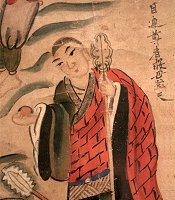

In addition to the "A series," the "Taizong's hell" project includes several other complete series of the underworld courts from the 19th and 20th centuries. Some are spread across ten scrolls - one for each court - whereas others are clustered on six, two or even just one scroll. These are here referenced as the "B series," the "C series" and so forth. "Taizong's hell" also includes many orphaned scrolls that no longer belong to complete sets, bringing the total to almost a hundred additional scrolls in our study collection. Together, all these scrolls are here offered as a database (with minimal annotation) for further research.
Yuli 玉歴 or Jade records are the textual equivalent to the late imperial hell scrolls, a literary genre that catalogues the tortures of each court. Presented here are 187 woodblock images from eight Yuli (or Yuli-like) texts, almost all from the 19th century.

The underworld courts give us the opportunity to see what was on the mental radars of their viewers. Their daily anxieties from being cheated in the marketplace to idle gossip became crimes to be posthumously tried. Their popular stories from "Mulian saves his mother" to "Having toured the underworld, Taizong returns to life" became the infrastructure of hell. Even their agricultural implements became instruments of torture. This section investigates the historical, artistic and literary forces that gave hell its shape.

I've begun creating teaching videos on various aspects of hell using these scrolls, here offering just my first on its tortures. Future videos may cover the sins addressed in hell, hell's landmarks, the famous stories that converge in hell, hell as a geographic space, how narrative and abstract Buddhism interrelate in hell and the moments of salvation that often frame the hell experience.
These videos are rather high resolution and may look blurry on some screens. You can also watch lower-resolution YouTube versions of them, the first linked here.

From scrolls to operas, from carved cliff faces to popular narratives, hell manifested itself through many media. Today students of hell can investigate late Chinese postmortem beliefs via scores of primary and secondary texts, via geographical sites in China and the Chinese diaspora, and via other websites. This section will provide interested students with a springboard into late Chinese thanatology.

The project now known as "Taizong's hell" began in the early 1970s under the guidance of Joe Kagle who collected many of these scrolls as a Fulbright scholar in Taiwan. Thirty years later, K.E. Brashier at Reed College purchased and expanded this collection, admittedly more as a hobby than as his own field of expertise. Since then it has anchored an academic course, namely "Death and remembrance in Chinese history"; it has been viewed by thousands at museum exhibitions; and it has become the subject of a constantly updated series of websites featured by on-line educational programs such as "Asia for educators" from Columbia University. Much work remains to be done in the future, including the development of an on-line network of all surviving hell scrolls.

Comments
Your comments, suggestions and insights are welcome. If you want to reach me, just search for my name (Ken Brashier) in the directory at the Reed College website.